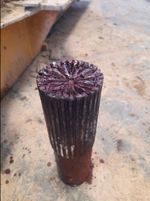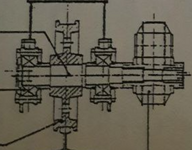fairyfales
Student
- May 28, 2025
- 7
I’m working on an engineering project analyzing the cause of repeated shaft failure in a translation gear reducer that drives a support wheel of a 400-ton bucket wheel excavator.

System Details
- Shaft material: 42CrMo4
- Motor power: 5.5 kW , n=1000 t/min
- Reducer output power: 4 kW
- Gear ratio: 150:1
- Number of support wheels: 16
- Each shaft supports 1 wheel (load ≈ 25 tons)
- Bearings: 2 cylindrical roller bearings
- Support wheel diameter: 710 mm
- Translation speed: Varies between 1.5 mm/min and 15 mm/min



